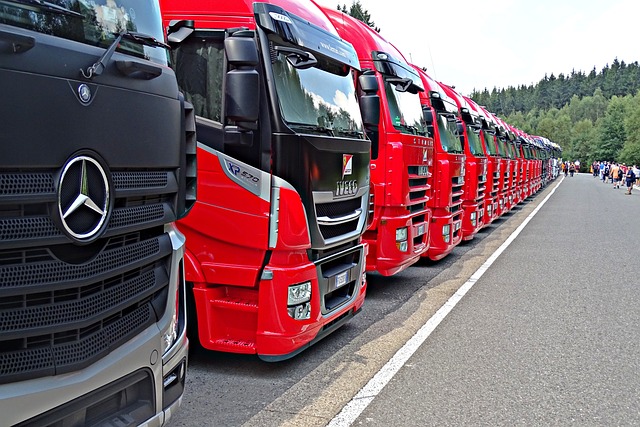Looking to register your car in California? This comprehensive guide covers everything from understanding the VIN verification process—a crucial step using your Vehicle Identification Number—to gathering essential documents. We’ll walk you through both online and in-person registration methods, ensuring a smooth experience. Learn about common issues and handy tips, making car registration in California effortless. Discover the key steps, including how to utilize a VIN verifier, for a successful process.
- Understanding the Vehicle Identification Number (VIN) Verification Process in California
- Gathering Necessary Documents for Car Registration
- Step-by-Step Guide to Registering Your Vehicle Online
- In-Person Registration: Visiting a California Department of Motor Vehicles (DMV) Office
- Common Issues and Tips for a Seamless Car Registration Experience
Understanding the Vehicle Identification Number (VIN) Verification Process in California

In California, understanding the Vehicle Identification Number (VIN) verification process is crucial for a successful car registration. The state requires a thorough check to ensure the vehicle’s authenticity and history. This involves verifying the VIN using official databases, which are linked to the manufacturer’s records, to confirm the vehicle’s make, model, year, and other critical specifications. A reliable method for this verification is through mobile vin verification services that conduct inspections on-site, offering convenience and accuracy.
Mobile vin inspectors play a vital role in this process by performing a detailed examination of the VIN plate, which is typically located on the vehicle’s dashboard or door frame. They use specialized tools to scan and cross-reference the VIN data with global databases, providing instant access to the car’s history, including ownership records, accident reports, and maintenance logs. This mobile vin inspection ensures that the vehicle meets all legal requirements before registration, safeguarding both consumers and government agencies from potential fraud or stolen vehicles.
Gathering Necessary Documents for Car Registration

Before heading to the California Department of Motor Vehicles (DMV) or any authorized registration center, make sure you have all the essential documents ready. The process often begins with gathering crucial information and proof of ownership, which is where a VIN verifier comes in handy. A Vehicle Identification Number (VIN) verifier allows for quick and easy mobile VIN verification, ensuring that your car’s details match the records. This can be done through an app or online service that checks the VIN against various databases to confirm its authenticity.
Once you’ve confirmed ownership, you’ll need to provide documentation such as a valid driver’s license or state ID, proof of insurance, and payment for registration fees. The DMV accepts several methods of payment, so it’s good to check their website for the most up-to-date information. Additionally, some centers offer the option for a mobile VIN inspection, which streamlines the process by allowing an inspector to verify your vehicle’s details on-site.
Step-by-Step Guide to Registering Your Vehicle Online

Registering your vehicle online in California is a straightforward process that can be completed quickly with the help of a VIN verifier. Here’s a step-by-step guide:
1. Obtain Your Vehicle Identification Number (VIN): Start by locating your car’s VIN, typically found on the vehicle’s title or registration document if you have them readily available. If not, check the driver’s side door jamb or engine bay for the VIN number. For added convenience, consider using a mobile VIN verification service that allows you to quickly and easily capture your VIN with your smartphone.
2. Choose an Online Registration Provider: California offers various online services for vehicle registration. Research reputable options and choose one that provides a user-friendly interface and supports mobile VIN inspection. Some providers may offer additional benefits like real-time updates on registration status or the ability to schedule appointments online.
3. Fill Out the Registration Form: Access the chosen provider’s website and locate the online registration form. Provide all the required information, including your personal details, vehicle specifications, and payment method. Ensure you have accurate data to avoid delays. The mobile VIN verification tool can assist in entering the correct VIN, making the process faster and more efficient.
4. Submit and Pay: Review your form for accuracy before submitting it. You’ll typically receive a confirmation once processed, and an email with instructions on how to pay any applicable fees. Some services allow payment through credit cards or online banking.
5. Receive Your Registration: After successful payment, you should be able to download your vehicle’s registration document digitally. Keep this record for future reference, and ensure your car’s registration is up-to-date with California’s Motor Vehicle Department (DMV).
In-Person Registration: Visiting a California Department of Motor Vehicles (DMV) Office

Visiting a California Department of Motor Vehicles (DMV) Office is one of the most straightforward ways to register your car in-person. This process involves several steps, ensuring that all documents are accurate and complete. When you arrive at the DMV, you’ll need to present essential paperwork such as proof of ownership, valid identification, and current vehicle insurance. The staff will verify your information using a Vehicle Identification Number (VIN) verifier, ensuring the vehicle’s details match the documentation.
During your visit, a representative will guide you through the registration process, which includes updating your personal information, paying the required fees, and passing any necessary inspections, like a VIN inspection. This method is ideal for those who prefer face-to-face interactions or need immediate assistance with car registration.
Common Issues and Tips for a Seamless Car Registration Experience

Navigating the car registration process can be a daunting task, filled with potential pitfalls and delays. Common issues include incorrect or incomplete documentation, inaccurate vehicle information, and discrepancies between the car’s history and the owner’s details. To ensure a seamless experience, start by gathering all necessary documents, such as proof of ownership, identification, and insurance. Double-check the Vehicle Identification Number (VIN) for accuracy; consider using a mobile VIN verifier to confirm its validity and history before initiating the registration process.
Additional tips include staying organized, arriving at the DMV with ample time, and being prepared to answer any questions about your vehicle’s history or your personal information. Remember that some issues might require additional steps or documentation. Leveraging tools like mobile VIN verification can streamline the initial checks, making it easier to address potential problems early on. This proactive approach helps prevent delays and ensures a smoother car registration process in California.
Registering your car in California involves a straightforward process, whether done online or in person. By understanding the Vehicle Identification Number (VIN) verification process and gathering the required documents, you can ensure a smooth experience. Utilize the step-by-step guides provided for online registration or visit a local DMV office if preferred. Remember to address common issues and follow tips for a seamless car registration journey, making it easier to navigate and ensuring your vehicle is legally registered in no time. Additionally, when dealing with a vin verifier, ensure accuracy for a stress-free process.
